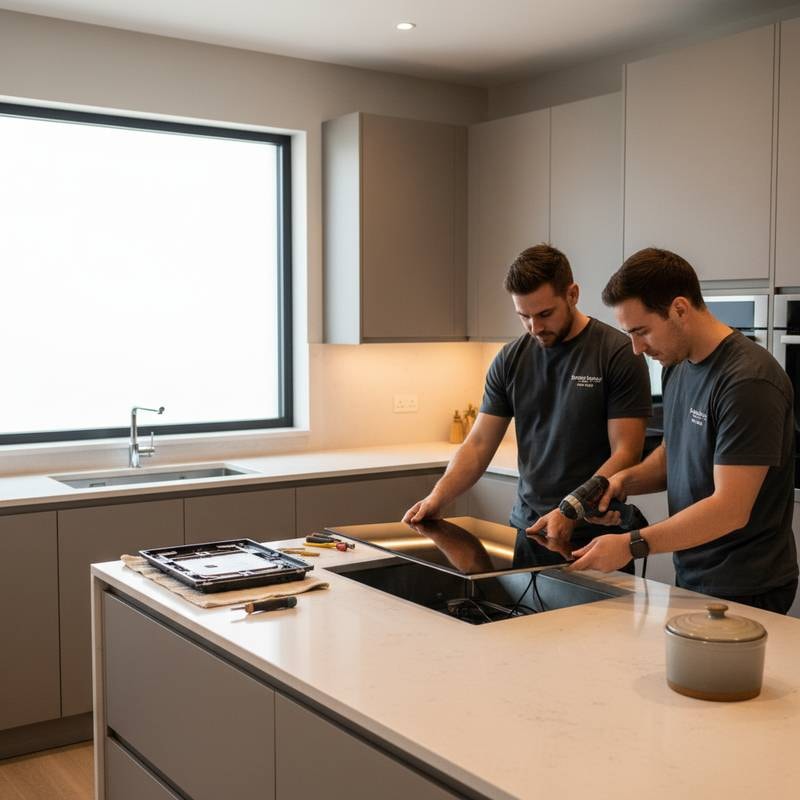Induction Retrofit: Skip the Full Kitchen Reno
Home cooks often face outdated gas or electric cooktops that deliver uneven heat and scratched surfaces. Induction cooking offers a compelling alternative with its rapid heating and precise control. A full kitchen remodel seems daunting with its high costs and extended disruption, yet an induction retrofit provides a streamlined upgrade that preserves existing cabinets and countertops.
This approach modernizes the cooking area efficiently. Homeowners gain advanced technology without major structural changes. The result delivers enhanced performance in a familiar layout.
Benefits of Induction Technology
Induction cooktops employ electromagnetic fields to heat pots and pans directly. This method avoids warming the surrounding surface, which leads to quicker boiling times and exact temperature adjustments. Safety improves markedly because the cooktop remains cool, reducing burn risks during operation.
Energy savings become evident through lower electricity use compared to traditional electric models. Indoor air quality enhances without gas combustion byproducts. Professional chefs and everyday users alike appreciate the responsiveness that rivals professional-grade equipment.
For kitchens with solid countertops and functional layouts, retrofitting stands out as a practical choice. It introduces premium features at a fraction of renovation expenses. Many users report noticeable improvements in cooking consistency and ease of use.
Steps in an Induction Retrofit Process
Retrofitting centers on exchanging the current cooktop for an induction unit that aligns with the existing setup. Compatibility with the countertop cutout minimizes alterations in most scenarios. Professional guidance ensures compliance and optimal results.
Follow these detailed steps to execute the project:
-
Assess the current cutout dimensions. Most standard cooktops measure 30 or 36 inches in width. Record the precise width, depth, and any irregularities to match the new unit accurately.
-
Evaluate electrical infrastructure. Induction units require higher amperage, often a 240-volt dedicated circuit. Consult an electrician to inspect the panel; upgrades might cost between $200 and $600 based on existing wiring and local codes.
-
Choose a suitable induction cooktop. Entry-level models begin at approximately $900, while high-end versions with advanced features reach $2,500 or more. Prioritize units with built-in trim kits designed for seamless retrofits, and consider burner configurations that suit daily cooking needs.
-
Engage a certified electrician. Electrical work demands adherence to safety standards. Even if countertop adjustments occur independently, professional wiring prevents hazards and ensures warranty validity.
-
Complete the physical installation. Position the cooktop into the prepared opening after electrical connections. Apply a silicone sealant around the edges to block moisture and debris from entering the cabinetry below.
Optional countertop adjustments, such as enlarging or reshaping the cutout, may involve a stone fabricator. These modifications typically add $100 to $300, with premium materials like granite incurring higher fees due to required precision tools.
Budget and Schedule Expectations
Total costs for a retrofit, encompassing the cooktop, electrical enhancements, and labor, generally fall between $1,200 and $3,000. This investment contrasts sharply with comprehensive kitchen overhauls that often exceed $20,000. Factors influencing the price include unit quality, regional labor rates, and any unforeseen electrical needs.
Installation timelines prove efficient, with most projects concluding in under eight hours once components arrive. Kitchen functionality resumes swiftly, limiting meal preparation interruptions. Planning ahead with measurements and consultations accelerates the process further.
Homeowners benefit from long-term savings on energy bills, potentially offsetting initial outlays within a few years. Resale value may increase as modern appliances appeal to energy-conscious buyers.
Key Factors to Address Prior to Installation
Preparation ensures a smooth retrofit. Address these elements to avoid delays or complications.
-
Verify cookware compatibility. Induction surfaces demand ferromagnetic materials. Attach a magnet to the pan base; adhesion confirms usability. Non-compatible items require affordable replacements, often available in sets starting at $50.
-
Review ventilation systems. While induction generates minimal excess heat, effective exhaust remains essential for steam and odors. Inspect the current range hood for adequacy; replacements enhance performance if the existing unit underperforms.
-
Secure necessary permits. Electrical modifications frequently necessitate local approvals. Contact the building department early to confirm requirements and avoid fines or rework.
-
Plan for ongoing care. Glass-ceramic surfaces clean effortlessly with mild soap and soft cloths. Avoid abrasive cleaners to preserve the finish and maintain efficiency over time.
Additional considerations include noise levels from cooling fans in some models and the learning curve for temperature settings. Testing the setup post-installation familiarizes users quickly.
Execute Your Kitchen Upgrade
An induction retrofit transforms cooking capabilities with targeted efficiency. It integrates cutting-edge technology into established spaces, yielding faster, safer, and more precise results. Existing infrastructure supports this change without extensive upheaval.
Begin by documenting measurements and assessing electrical readiness. Schedule consultations with electricians and suppliers to select components. Soon, the kitchen evolves into a more responsive and enjoyable environment, centered on reliable performance.










